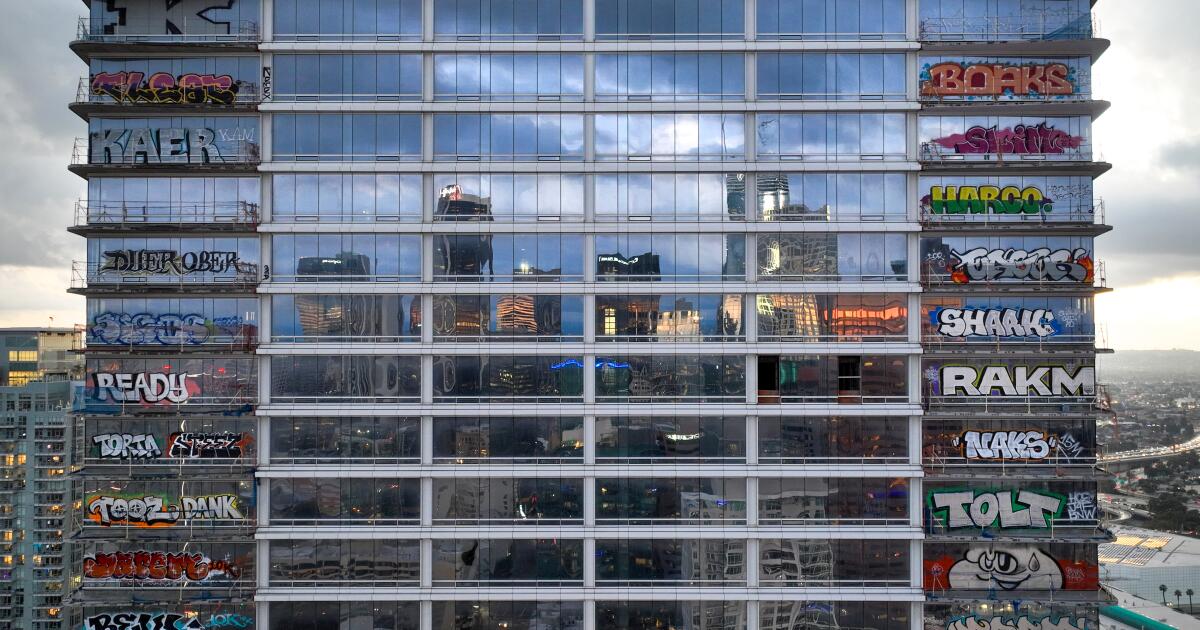Early last year, vandals breached fencing, climbed dozens of flights of stairs and painted bold, colorful graffiti on the exterior of three unfinished high-rises that make up the abandoned Oceanwide Plaza development.
The so-called Graffiti Towers — visible from great distances on the 110 Freeway and looming over thousands of visitors attending events across the street at Crypto.com Arena — were expected to be sold in a bankruptcy auction a year ago.
But the long-running bankruptcy sale of downtown Los Angeles’ most spectacular eyesore drags on with no clear end in sight. Experts blame a confluence of factors, including high interest rates, rising construction costs and delays in attracting viable bidders.
Construction on what would have been one of the city’s most notable landmarks, with high-rise housing, a hotel and a shopping center, halted in 2019 when Beijing-based conglomerate Oceanwide Holdings ran out of money to pay contractors after spending $1.2 billion on the complex that fills a large city block on Figueroa Street.
Business leaders have expressed alarm that the graffiti some find artistic will prove embarrassing when global attention is focused on the World Cup next year and the Summer Olympics in 2028.
Resolution of the Oceanwide Plaza saga also can’t come soon enough for many downtown stakeholders who see the graffitied towers — rising as high as 49 stories — as a dark presence besmirching the city and sending a negative message about the neighborhood.
“The Graffiti Towers have worldwide infamy at this point,” said Cassy Horton, co-founder of the DTLA Residents Assn. “It’s like this beacon that shines and says, ‘Come create mischief down here and you won’t get in trouble. This is the spot to do it.’”
A rendering of proposed advertising signs on the Oceanwide Plaza towers in downtown Los Angeles that are now covered with graffiti.
(HansonLA)
The graffiti is likely to remain until a new owner takes on the painstaking task of removing it.
More than a year ago, a federal judge set a Sept. 17 auction of the property, saying there were several potential bidders. The winner of the auction ultimately wasn’t able to come up with the promised purchase price and negotiations commenced with other bidders.
The real estate broker managing the sale, Mark Tarczynski of Colliers, declined to comment on the status of the sale but told real estate publication the Real Deal recently that two real estate development companies, one from the U.S. and one from abroad, are now competing as bidders. He said he anticipates closing the deal by the end of the year.
The purchase price, which would be used to pay creditors including general contractor Lendlease and EB-5 visa investors, would just be the beginning of expenses for the new owner. Estimates to complete the project reach $1 billion, even though it is about 60% completed.
Challenges to get it done include market conditions that are hamstringing other planned real estate developments. Builders complain of high interest rates for borrowing money to finance construction.
New tariffs are driving up the cost of imported construction materials while raising uncertainty about how long the tariffs may last or what new ones may arise. Labor costs have also been increasing in recent years, and the recent Immigration and Customs Enforcement raids have added a destabilizing effect on the construction labor pool, industry observers have said.
Los Angeles architect Douglas Hanson, who designed the 35-story Circa apartment complex next to Oceanwide Plaza, has an idea to shield people’s gaze from the graffitied towers and bring in some money.
A rendering of a proposed covering on the east side of Oceanwide Plaza towers in downtown Los Angeles that are now awash in graffiti.
(HansonLA)
He suggests rolling down vinyl advertising signs that could be seen on the from the freeway on the west side of the complex and lowering other vinyl coverings on the east side that would display a beach scene or some other art.
“You can get good money for advertising in that neighborhood,” which allows large commercial displays, Hanson said. Ad revenue would more than pay for the signs, he said.
The buildings wouldn’t be fully wrapped like a Christo art project, he said. “Just drape them down and leave a little bit of the history of the building behind them.”
The Oceanwide Plaza site was a sprawling asphalt lot used for event parking when Oceanwide Holdings bought it in 2014 with a vision to build a fancy, mixed-use development that was far bigger in scale than what is typically built in the U.S.
Oceanwide set to work on the complex, which was intended to house luxury condominiums, apartments, a five-star Park Hyatt hotel and an indoor mall that would include deluxe shops and restaurants. A massive electronic sign on its facade was to bring a flavor of Times Square to Figueroa Street.
Many of the residents and visitors were expected to be Chinese citizens, but the country’s government implemented tighter controls on money leaving the country in 2019 and the pool of potential condo buyers shrunk.
